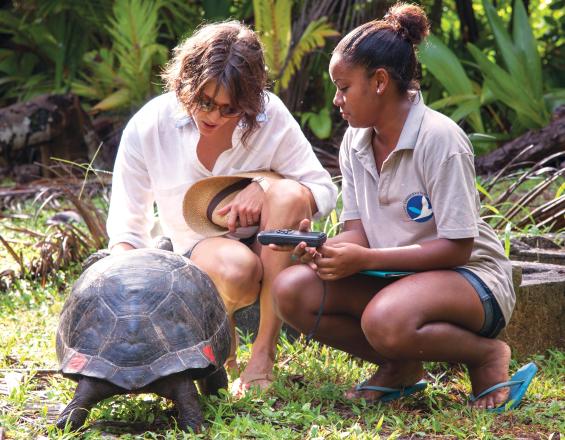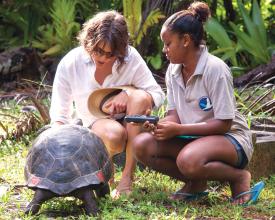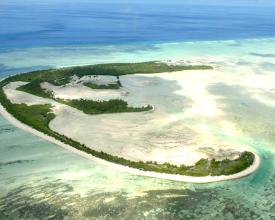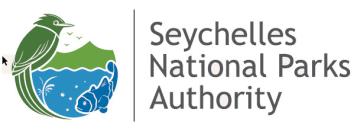Gouvernance inclusive de la conservation sur les îles éloignées : Les leçons des Seychelles

Les Seychelles sont situées dans l'océan Indien occidental, entre Madagascar et la Corne de l'Afrique. C'est un archipel composé de 155 îles (selon la Constitution), réparties sur plus de 1,4 million de kilomètres carrés de zone économique exclusive (ZEE).
L'Island Conservation Society (ICS), une organisation non gouvernementale des Seychelles, a travaillé avec ses partenaires pour développer un nouveau modèle de financement pour la gestion de la conservation sur les atolls insulaires éloignés. Ce modèle implique la création de fondations, dont les membres sont des représentants du gouvernement, des organismes parapublics/entreprises publiques, des investisseurs touristiques privés opérant sur les îles, ainsi que de l'ICS. Chaque fondation garantit une prise de décision conjointe et la transparence de la gestion environnementale sur les îles, ainsi que l'autosuffisance financière. Depuis 2006, 11 fondations ont été créées pour 13 groupes d'îles. Six d'entre elles sont entièrement financées par des programmes de conservation actifs, et trois d'entre elles disposent de fonds de dotation.
Contexte
Défis à relever
L'éloignement : Parce qu'elles ne sont pas immédiatement visibles, les îles éloignées, rarement visitées par les citoyens locaux, peuvent tomber dans l'oubli. Cela pèse sur la disponibilité des financements. C'est pourquoi, grâce au soutien du projet GOS-PNUD-FEM sur les îles extérieures, les îles ont élaboré des plans d'affaires pour relever ce défi. L'accent est également mis sur la communication, afin que les îles ne soient pas oubliées, mais prises en compte dans les décisions nationales.
Répondre aux attentes : Les Fondations comptent des membres ayant des points de vue différents sur les objectifs à atteindre. Il est donc nécessaire de faire des compromis et de poursuivre le dialogue. Le nombre d'acteurs opérant sur les îles étant limité en raison de leur éloignement et de leur petite taille, l'adhésion aux fondations se limite souvent à quelques organisations (représentées par des personnes qu'elles désignent), ce qui peut limiter le nombre de points de vue et d'idées nouvelles.
Emplacement
Traiter
Résumé du processus
Chaque élément se renforce mutuellement. Le plan de gestion de la conservation guide la prise de décision de la Fondation, et la Fondation influe sur les contributions et les performances du Fonds de dotation.
Blocs de construction
Création d'une fondation
La Fondation est enregistrée en tant qu'ONG et est dotée de statuts conformes à la législation nationale. Une fois créée, un accord multipartite est élaboré pour définir les responsabilités et les contributions de chaque membre de la Fondation. La Fondation est normalement composée d'un représentant de l'Islands Development Company (IDC) qui détient le bail de l'île, de deux représentants de l'Island Conservation Society (l'ONG qui mène les activités de conservation sur l'île) et d'un siège réservé à l'investisseur qui mène divers projets de développement sur l'île. La Fondation crée donc une plateforme obligatoire où toutes les parties prenantes présentes sur l'île doivent se rencontrer pour discuter des questions importantes et convenir d'une marche à suivre.
Facteurs favorables
Un environnement réglementaire clair est nécessaire pour garantir la création et la gestion transparentes et sans ambiguïté d'une entité à but non lucratif ; dans le cas des Seychelles, c'est le Registre des associations qui s'en charge. Des lignes directrices très claires ont été établies pour garantir des audits réguliers, la publication des comptes et la tenue de registres appropriés concernant les membres et les délibérations. Ces mesures garantissent que les fondations restent transparentes et efficaces dans la manière dont elles gèrent les activités de conservation sur les îles extérieures, qui sont les biens de la population des Seychelles.
Leçon apprise
Il est essentiel que la Fondation comprenne les bonnes personnes et les membres qui s'intéressent activement à la conservation. La formation des membres sur les questions importantes de conservation et la production de rapports techniques de qualité sont nécessaires pour soutenir le processus décisionnel de la Fondation.
Fonds de dotation
Le Fonds de dotation est établi pour permettre aux membres de la Fondation de contribuer financièrement à la gestion de la conservation sur l'île. Il permet également d'investir le capital afin de générer un revenu à perpétuité. L'excédent à la fin de l'année financière est généralement transféré dans le fonds de dotation qui est géré par une société d'investissement internationale. Le retour sur investissement est soit réinvesti dans le fonds de dotation, soit utilisé pour soutenir des projets environnementaux prioritaires sur l'île.
Facteurs favorables
Un acte constitutif pour la création du fonds, des lignes directrices opérationnelles stipulant les règles et procédures de gestion du fonds et l'utilisation des recettes, ainsi que des contributions suffisantes pour générer un revenu à partir de la dotation.
Leçon apprise
Soutenir les îles qui manquent de ressources : Certaines îles ont des fondations actives dont les contributions financières couvrent plus que suffisamment la gestion de la conservation. Cependant, d'autres fondations ayant moins d'activités économiques ou des habitats extrêmement sensibles reçoivent moins de ressources. Par conséquent, la promotion des subventions croisées entre les fondations permettrait de soutenir les îles moins bien dotées en ressources, mais dont les écosystèmes sont tout aussi importants, et de contribuer à soutenir les îles frappées par des catastrophes naturelles, telles que les cyclones.
Plan de gestion de la conservation
Le plan de gestion de la conservation guide la mise en œuvre de la meilleure utilisation possible des revenus générés. Le plan, approuvé par la Fondation, fournit des plans de travail annuels chiffrés pour guider les membres de la Fondation et l'équipe de mise en œuvre du SCI, et détaille les rapports annuels requis sur les résultats des activités existantes.
Facteurs favorables
Des ONG compétentes et respectées pour entreprendre l'élaboration du plan de gestion, la mise en œuvre et l'établissement de rapports sur ses activités.
Leçon apprise
Une prise de décision claire : Pour que la gestion de la conservation sur les îles soit efficace, chaque réunion de la Fondation doit se conclure par des décisions claires et réalisables. L'ambiguïté des décisions peut conduire à une incertitude sur la façon de procéder dans l'intervalle, en particulier pour le personnel de conservation sur le terrain. L'intégration d'un secrétariat pour gérer les opérations des fondations (dans notre cas, géré par ICS) garantirait que les décisions de haut niveau se traduisent par une mise en œuvre basée sur les activités.
Impacts
Les fondations ont déjà eu une série d'effets sur la conservation des îles qu'elles soutiennent, à savoir
- Transparence et équité : Les fondations sont composées d'investisseurs privés sur les îles, du gouvernement (ministère de l'environnement, organismes parapublics tels que l'Islands Development Company et la Seychelles National Park Authority) et d'ONG. Les fondations sont copropriétaires et disposent d'un droit de vote égal sur les décisions prises. Chacune est régie par une constitution et un accord entre les parties prenantes des îles.
- Financement de la conservation : Les fondations sont responsables du financement durable des efforts de conservation sur les îles. Il s'agit de contributions directes des investisseurs touristiques sur les îles, sous la forme d'une redevance fixe par client ou d'une proportion du chiffre d'affaires. En outre, les paiements au titre de la responsabilité sociale des entreprises (RSE) sont versés par les investisseurs touristiques à la Fondation pour les activités de conservation et pour constituer un fonds de dotation permanent. IDC fournit l'hébergement, le transport, le soutien logistique et la RSE.
- Gouvernance : La Fondation supervise la mise en œuvre du plan de gestion de la conservation sur l'île dans sa sphère de responsabilité.
Bénéficiaires
Les promoteurs et les opérateurs privés des îles bénéficient de l'amélioration des ressources nationales en matière de conservation sur les îles et en apprennent davantage sur la conservation.
Les citoyens seychellois bénéficient d'une meilleure connaissance des îles et de la protection de leur patrimoine.
Objectifs de développement durable
Histoire
La Fondation Alphonse a été créée en 2007. Les administrateurs fondateurs étaient issus de l'Islands Development Company, de l'Island Conservation Society, d'investisseurs opérant sur l'île à l'époque et du ministère de l'environnement des Seychelles. La Fondation Alphonse a été l'une des premières fondations créées pour soutenir les efforts de conservation de l'environnement sur les îles extérieures des Seychelles. Au fil des ans, elle a joué un rôle essentiel dans l'équilibre entre les activités de conservation et de réhabilitation des atolls d'Alphonse et de Saint-François et le développement durable d'un écotourisme à faible impact.
L'île d'Alphonse est aujourd'hui connue comme une destination mondiale importante pour la pêche à la mouche de la carangue géante et d'autres espèces cibles. Il existe actuellement un opérateur sur l'île qui organise des activités de pêche à la mouche au large du récif avec des touristes internationaux.
Cependant, la Fondation Alphonse souhaitait connaître l'impact des opérations de pêche sur l'environnement, afin de s'assurer que les activités autorisées n'auraient pas d'impact négatif à long terme sur l'écosystème sensible. C'est pourquoi, en partenariat avec les opérateurs, un programme de recherche innovant visant à suivre les mouvements des carangues géantes autour de l'atoll est mené afin de comprendre les actions de gestion correctes, telles que l'ouverture et la fermeture des différentes zones.
Ce projet est soutenu financièrement par une subvention du Seychelles Conservation and Climate Adaptation Trust (SeyCCAT), de la Fondation Alphonse et de ses membres, de l'Université du Massachusetts Amherst, ainsi que d'autres partenaires internationaux.
L'objectif de l'opérateur privé est d'utiliser la science pour informer ses activités commerciales. Les guides de pêche travaillant pour l'opérateur de pêche à la mouche aident à marquer les poissons et à informer les clients du projet et de l'importance de ses résultats.
L'impact de la pêche à la mouche sur les écosystèmes est peu connu et ce projet permettra de tirer des enseignements et de reproduire le modèle sur d'autres îles.




